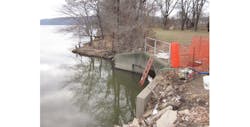A 60-in. reinforced concrete pipe (RCP) outfall line that runs from two skimmer ponds on the John Deere Works property in Dubuque, Iowa, and services industrial chill water and storm water had developed a problem—a sinkhole that had developed above it near the discharge into the Mississippi River. The 60-in. RCP conduit is owned by John Deere Works and is partially located in an easement on private property. The sinkhole had raised the concerns of a nearby homeowner and was causing safety issues for anyone walking in the vicinity.
When notified of the sinkhole, John Deere Works contacted McDermott Excavating—also located in Dubuque—which was under contract to provide site and underground infrastructure maintenance. After an inspection of the pipe and surrounding area was completed, it was determined that the most likely cause of the sinkhole was some displacement and a 2-in. separation at the last joint of the pipe before the headwall where it discharges into the Mississippi River. The slightly open joint was allowing rainwater to infiltrate, which caused soil from outside the pipe to erode and migrate in along with the water, creating the sinkhole.
Solution
In response to the findings of the inspection, McDermott Excavating researched a variety of trenchless methods and technologies for the repair of larger diameter pipes. It found the HydraTite internal joint seal offered by Cretex Specialty Products of Waukesha, Wisc.
The HydraTite internal joint seal system provides a mechanical, trenchless remediation of defective pipe joints. It consists of a proprietary rubber seal that spans the joint and is held in place by stainless steel retaining bands on either side of the joint. These retaining bands are expanded into place, compressing the rubber seal, and are then held in place with wedge locks to ensure a watertight seal and eliminate all infiltration or exfiltration at each joint.
Installation
Installation of the HydraTite system requires a properly trained and certified installation contractor, and McDermott Excavating had neither seen nor installed the system before. Cretex Specialty Products agreed to and made arrangements to provide installation training on site for a nominal fee in conjunction with the actual seal installation during repair of the pipe. The flow of the pipe was to have been diverted during installation, but due to unforeseen circumstances, that was not the case. When the contractor and personnel from Cretex Specialty Products arrived on site, there was approximately 18 to 24 in. of standing water in the pipe. Sandbags were placed at the discharge end of the pipe and an attempt was made to pump the water to reduce the level, but that was unsuccessful.
Since the HydraTite system can be installed in live flow, the decision was made to install the seal without further reduction of the water level in the pipe. The rubber seal, retaining bands, hydraulic expansion tool and hand tools were handed to the two technicians (one from McDermott and one Cretex employee) in the pipe that would be performing the installation. The surfaces of the pipe on either side of the joint were inspected, cleaned and repaired where necessary. A series of alignment marks were made on the pipe to properly locate the seal for installation.
The rubber seal was positioned at the joint, opened and “popped up” into place in the pipe. Prior to placing the stainless steel expansion bands, the area at the invert of the pipe behind the seal was checked for any debris, silt or stones that may interfere with the installation. Once checked for debris, the first of two expansion bands was assembled and positioned against the rubber seal. The retaining band was expanded using the special hydraulic expander tool to a pressure of approximately 4400 psi. Once tight, the proper-width wedge lock was selected and driven into position to hold the band in its expanded, tightened position. The second band was then assembled and installed using the same expander tool and wedge lock to complete the installation process. The entire installation of the HydraTite internal joint seal was accomplished in less than an hour by two technicians.
Result
With the defective joint now sealed, the sinkhole was filled in, and future soil migration has been prevented with no further ground settlement issues above the pipe.
Lee Haessig is general manager for Cretex Specialty Products. Haessig can be reached at [email protected] or 800.345.3764.







